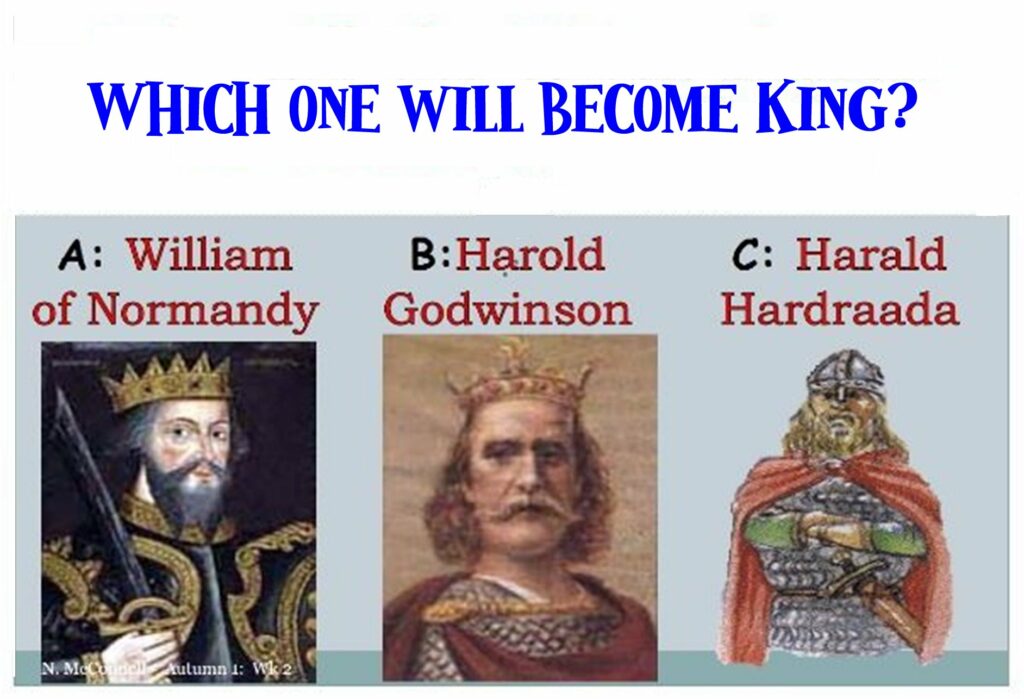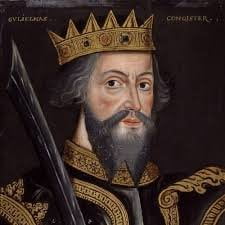
At the start of 1066, England was ruled by King Edward the Confessor, he is remembered as the King who built Westminster Abbey in London.
Edward ruled over England with the help of the Witan. It was made up of the top clergy in the country and acted as his council on all matters concerning the church. It was through the Witan that Edward derived his legitimacy to rule the country.
What happens when the King died, who becomes his successor?
In 1066 it was different to today. Sometimes a King named his own successor, however English and Norman ideas about this were different, and that is what led to 1066.
To Explain
The English Custom
Was that the dying King’s ‘last words’ took precedence over any promises made before that. An earlier promise was stronger if that had been ‘kept’. This is when the current king had crowned his successor and shared the throne from that point on.
The Normand Custom.
They believed that an earlier promise of the throne was seen as final and could not be overturned on the king’s death bed.
Edward the Confessor died.
He died on the 5th January 1066 and had no children. Therefore no one knew for sure who was to become King.
This is what led to the two battles that changed history that year, due to the confusion as to who should have been King. Basically, four people put forward their claim to the throne and three of them decided to do something about it. Unfortunately, they came from different countries and had conflicting levels of support.
Harold became King.
![]()
Edward the Confessor died on 5th January 1066, with Harold by his side. The next day Harold was crowned as king, witnessed by prominent nobles. He was popular with the English Lords as he had practically been running the country as the Sub-regulus, which in those days was described as a deputy king, he even led the King’s army in battle.
Harold was crowned in Westminster Abbey on the same day as King Edward was buried. However, he was well aware that he would have to fight to defend his kingdom from the other claimants to the throne.
The Foreign Reaction to Harold’s crowning.
Unfortunately, there were two others who thought they had been promised the throne, William, Duke of Normandy and King Hadrada. Both were mad with Harold for accepting the throne. Both prepared to invade England.
Harold Hadrada
 He is best known as Harold Hardrada, which means ‘hard ruler’. He became king of Norway in 1045, unsuccessfully claimed the Danish crown and then in 1066 he decided to claim the throne of England.
He is best known as Harold Hardrada, which means ‘hard ruler’. He became king of Norway in 1045, unsuccessfully claimed the Danish crown and then in 1066 he decided to claim the throne of England.
He was helped in this by Tostig, who was Harold’s brother and had been the Earl of Northumbria. He had been exiled by Harold and King Edward after the Northumbrians rebelled against his unpopular and ruthless methods of ruling them. He wanted revenge and knew that by joining up with Hadrada he could get it. It is thought that they knew of William’s invasion and hoped that while Harold was distracted by it, they could invade from the North and take power relatively easily.
Meanwhile
 William was planning to invade Southern England and raised an army from Normandy, along with hired mercenaries, while seeking support from rulers throughout Europe. While preparing, he also sent an envoy to the Pope to plead for Harold’s excommunication from the Church. This was because when William saved Harold from a shipwreck in the Channel, Harold made a sacred religious oath that on Edward’s death, he would support William to be king. William succeeded in getting Harold excommunicated and gained support from many of Europe’s leaders.
William was planning to invade Southern England and raised an army from Normandy, along with hired mercenaries, while seeking support from rulers throughout Europe. While preparing, he also sent an envoy to the Pope to plead for Harold’s excommunication from the Church. This was because when William saved Harold from a shipwreck in the Channel, Harold made a sacred religious oath that on Edward’s death, he would support William to be king. William succeeded in getting Harold excommunicated and gained support from many of Europe’s leaders.
The Battle of Stamford Bridge.
Hadrada, Tostig and their army landed first. They had sent three hundred ships full of men across the North Sea and landed on the coast near York. They defeated the English garrisons at Fulford Gate and prepared to take control of the area. Harold heard about the landing, he immediately raised an army and marched north.
The speed of Harold’s march north surprised Hadrada, whose army wasn’t prepared for battle when they attacked on the 25th September 1066 at Stamford Bridge. The Vikings could not respond to this surprise attack and were almost completely destroyed. Both Hadrada and Tostig were killed and only 24 ships managed to set sail back to Norway.
However, just as Harold was celebrating his victorious destruction of the Vikings, William’s army was landing in the South. His army landed at Pevensey Bay on the 28th September 1066.
Harold had no choice but to force his weary army to march to the South to engage William’s army. They marched 250 miles in only 9 days! This, of course, meant that this was an exhausted army. They had just completed two long marches up and then back down the length of the country, and were not in the best condition to fight another major battle.
On October 14th, the Norman army began to set up positions at the base of the hill. The two armies, who were roughly of equal size, were face to face and ready to do battle.
What happened next was the Battle of Hastings, and that changed whole history of England.

Educational Musicals have a children’s musical
1066 – The Battle of Hastings.
which you can download at 1066 – The Battle of Hastings.
Isn’t History fun?
Ten questions to discuss:
- Who ruled England at the beginning of 1066?
- What was the role of the Witan in Edward the Confessor’s reign?
- What were the differences between English and Norman customs regarding the succession of the throne?
- How did Edward the Confessor’s death lead to a succession crisis?
- Who became the King of England after Edward the Confessor’s death, and how did he ascend to the throne?
- Who were the two other claimants to the English throne besides Harold?
- Describe Harold Hardrada’s claim to the English throne and his alliance with Tostig.
- How did William, Duke of Normandy, prepare for his invasion of England?
- What was the outcome of the Battle of Stamford Bridge?
- What led to the Battle of Hastings, and what was its significance in English history?
For more information click on:
©Tony Dalton


